Thu 15 Apr 2010
Kicking Ass and Taking Names
Posted by Ethan under Film Review, NYC Film Critic
1 Comment
Kick-Ass
Directed by Matthew Vaughn
Starring Aaron Johnson, Christopher Mintz-Plasse, Chloë Grace Moretz, Nicolas Cage.
**1/2
Matthew Vaughn’s Kick-Ass begins in the real world and ends up firmly in comic-book land. I suppose that’s only appropriate seeing as how the film is adapted from a comic-book, an eight-issue limited series by celebrated comics scribe Mark Millar. On the page at least, Millar aimed for a tone that was both outlandish and grittily real; the violence was over-the-top (the amount of blood and gore on display rivals an Evil Dead flick) but the characters were all too human, marching into battle with little besides their fists, batons, or, in one case, a flame-thrower, and frequently coming away with serious injuries.Â
Kick-Ass The Movie follows Millar’s approach up to a point, but when a film climaxes with a massive penthouse shoot-out that involves, among other things, a bazooka and a freakin’ jet pack with mounted machine guns, you know the filmmakers have left reality behind in favor of the anything-goes physics present in most four-color superhero adventures.
There are several other differences, some minor and some more significant, between the comic and the film, but it seems unnecessary to devote this entire review to describing each one in detail. Besides, Millar himself ridicules that kind of compare-and-contrast evaluation in the pages of Kick-Ass when he has his main character, a geeky teenage comic-book enthusiast named Dave Lizewski, mock a fellow fanboy friend for complaining about how comic-book movies invariably make changes to established canon. (The examples Dave cites in the comic include the cinematic Spider-Man’s organic webshooters and the Nimbus cloud that stands in for the purple-suited world-devourer Galactus in the second Fantastic Four flick, both of which are famous points of contention in online forums.) “What works on the page doesn’t always work on the screen, asshole†he tells him in exasperation, which could have been Vaughn’s rallying cry in adapting the comic into a film.
Actually, on a purely narrative level, the director has remained quite faithful to Millar’s work—certainly more so than on his last comic-book adaptation, a botched version of Neil Gaiman’s beautiful fairy tale Stardust. And, in general, the changes that have been made affect the overall mood rather than the overarching narrative. Simply put, Vaughn’s Kick-Ass is a lighter, more crowd-pleasing ultraviolent superhero spoof than Millar’s unapologetically mean and nasty exercise in shock comedy.
Like the book, the movie follows the misadventures of dorky Dave (played by British actor Aaron Johnson) and his costumed alter-ego, the would-be vigilante hero Kick-Ass. Clad in a green wetsuit with matching mask, this not-so-dark knight prowls the streets of New York City (doubled—badly—by Toronto and London) looking for citizens to rescues and criminals to beat up. The joke, of course, is that he’s completely unprepared to save anyone, including himself. During his first fight, he’s beaten, stabbed and then run over, ending up in the hospital where he’s stitched back together through several operations and months of recuperation.
You’d think that experience would be enough to convince him to hang up his tights, but crime-fighting proves to be as addictive as any hard drug. As soon as he’s back on his feet, he’s back in his costume and this time he actually succeeds in kicking bad guy ass in a brutal fight that’s captured via cameraphone in a video that instantly becomes a YouTube sensation. Like every plugged-in member of his generation, Dave knows how to leverage this fame, setting up a Kick-Ass MySpace page (although he really should be using FaceBook and Twitter instead) and interacting with his fans from the comfort of his bedroom.
Kick-Ass’s origin story occupies roughly 30 minutes of the movie’s two-hour runtime and it’s easily the most entertaining and clearly thought out section of the film, largely because it puts its title character front and center. Dave’s high-school hell is effectively realized—it’s very clear why he chooses to escape into comic-books—and the scene featuring his crimefighting debut crackles because it so neatly subverts what we’ve come to expect from big-budget superhero pictures. As a rule, I’m not a fan of unnecessary voiceover, but the narration here contains some very funny observations about fandom and contemporary teen life and is delivered terrifically by Johnson, who comes across as kind of a modern-day Ferris Bueller…if Bueller was the biggest loser in school, of course.
The fundamental problem with Kick-Ass in both of its incarnations is that, at a certain point, Kick-Ass stops being the star of his own adventure. After so cleverly establishing the concept of a talentless teen vigilante, both Millar and Vaughn proceed to ignore him, no doubt realizing that, realistically, there’s nowhere for the character to go but into his own grave. Instead, the focus shifts to a pair of actual (anti)heroes, Big Daddy and Hit Girl (played by Nicolas Cage and Chloë Grace Moretz respectively), a father-daughter act who are out to take down one of the city’s most notorious gangsters, Frank D’Amico (Mark Strong), for reasons that are highly personal in nature. Also entering the scene is another amateur avenger Red Mist (Superbad’s Christopher Mintz-Plasse), the son of the aforementioned crime boss desperately eager to prove his worth to his dad.
As Kick-Ass recedes from view, the movie noticeably loses its real-world edge and more overtly channels comic-book hijinks, albeit in a more graphic way than, say, your average issue of Action Comics. The pacing also starts to flag, as Vaughn wastes valuable screentime on a truly stupid relationship between Dave and his high-school crush Katie (Lyndsy Fonseca), which begins as a case of mistaken sexual identity—she thinks he’s gay and adopts him as a pal—and improbably blossoms into an actual romance. (It’s worth pointing out that this is one of the biggest points of departure between the film and the comic and speaks to how Vaughn goes out of his way to indulge the fantasies of the fanboys in the audience. Without giving anything specific away, let’s just say that Millar brought Dave and Kate’s relationship to a far more believable, if unabashedly cruel, conclusion.) I’m sorry to say that the Red Mist storyline is a wash as well, primarily because Mintz-Plasse doesn’t have any range as an actor. As much as I adored his McLovin persona in Superbad, it’s become increasingly clear that he’s not up to the task of performing roles that require hitting notes beyond aggressive geekiness.
After a saggy middle, the proceedings pick up again in the final act, when the battle between D’Amico and the Big Daddy/Hit Girl team finally erupts in a lengthy set-piece that’s packed gunfire, explosions and general mayhem. And having at last fully embraced comic-book aesthetics, Vaughn thankfully awakens from his stupor behind the camera. Like his previous movies, much of Kick-Ass is entirely impersonal and undistinguished from a visual standpoint; as a filmmaker, Vaughn lacks an eye for interesting compositions and often struggles to establish a consistent scene-to-scene rhythm. (His main strength is finding and nurturing young talent, hence the strong performances by Johnson and Moretz…more on her in a moment.) But there’s always one sequence where he rises to the occasion and the climax of Kick-Ass is a genuine crowd-pleaser, albeit one that’s heavily cribbed from a variety of other movies, from The Matrix to Hard Boiled.
To be honest, the climax is so overblown it feels out of step with the rest of the movie. Unlike Edgar Wright’s cop comedy Hot Fuzz—a film’s that’s clearly a reference point for Vaughn in the way it gradually morphs from a genre spoof into a crazily awesome action flick in its own right—Kick-Ass doesn’t build to its free-for-all ending in a convincing way. Instead what you have is a movie with a strong first and final act that are wildly different in tone bridged by a poorly plotted middle section that drags on for much longer than it needs to.
I can’t close out this review without discussing Hit Girl, who is at once both the movie’s best asset and a sign of what it does wrong. Much ink has already been spilled about this character and I want to be clear that I’m not about to launch into a tirade about the film’s morality (or lack thereof) like this guy or even this guy. (Honestly, I was much more offended by Vaughn’s poorly-conceived use of a Daniel Pearl-like execution video in an earlier scene.) I certainly don’t object to the decision by Moretz—who was 11 when the film was made—and her parents to take on the role. Fact is, Hit Girl is the film’s breakout character, the one that moviegoers will come away buzzing about and that’s due entirely to the bravado that the young actress brings to the part. (Well, that and the well-established rule that a foul-mouthed kid never fails to get a laugh—see Role Models and Cop Out.)
I also don’t take issue with the general concept of Hit Girl, who is clearly intended to be a twisted send-up of Golden Age kiddie sidekicks like Robin, Bucky or Aqualad as well as a tip of the hat to the prepubescent-looking female warriors that populate Japanese manga and anime. At least, that’s how the character came across in the book thanks to artist John Romita Jr.’s exaggerated artwork, which enhanced her cartoonish qualities.
But to turn Millar’s words back on him, what works on the page doesn’t always work on the screen. In the context of a live-action movie, it’s hard not to be at least a little unsettled by the sight of a child actress slaughtering a literal army of heavily armed adults, even if they are “bad guys.â€Â Actually, the thing that bothers me the most about the cinematic Hit Girl isn’t that she kills people—it’s that she takes such obvious pleasure in doing it. Watching Moretz smile and laugh while stabbing a drug dealer throw the heart with a giant sword or blow away dozens of D’Amico’s henchmen with a pair of guns John Woo-style, I couldn’t help but think of child soldiers in Africa who are similarly conditioned to take pleasure in killing. It’s safe to say that moviegoers wouldn’t laugh and cheer on an 11-year-old African gunman in the same way Kick-Ass encourages us to root wholeheartedly for Hit Girl without contemplating the psychological damage she’s experienced to arrive at this point.
Granted, Vaughn is ostensibly making a broad comic-book satire and not a documentary about child soldiers, but a better movie would have at least shown an interest in dealing with the issues a character like Hit Girl raises. For better or for worse though, (and in my opinion anyway, it’s the latter) Kick-Ass has been constructed to shock and awe rather than to support and value deep thought. In that way, it reaffirms the juvenile label that is often ascribed to comic-books in general. That the movie ends with Dave achieving his dream of being a big-time superhero—the guy who gets the girl and gets to kick some ass (in fact, he even takes a cue from Hit Girl and kills a few evildoers as well, a development that Millar noticeably avoided)—indicates Vaughn’s willingness to pander to rather than challenge his fanboy audience. Which brings us back to where we started: Kick-Ass begins as a picture that wants to inject a dose of reality into comic-book movie conventions only to wimp out and reinforce the status quo. Is it entertaining? Sure, at times. But it’s also a woefully shallow and silly picture.
Kick-Ass opens in theaters on Friday.
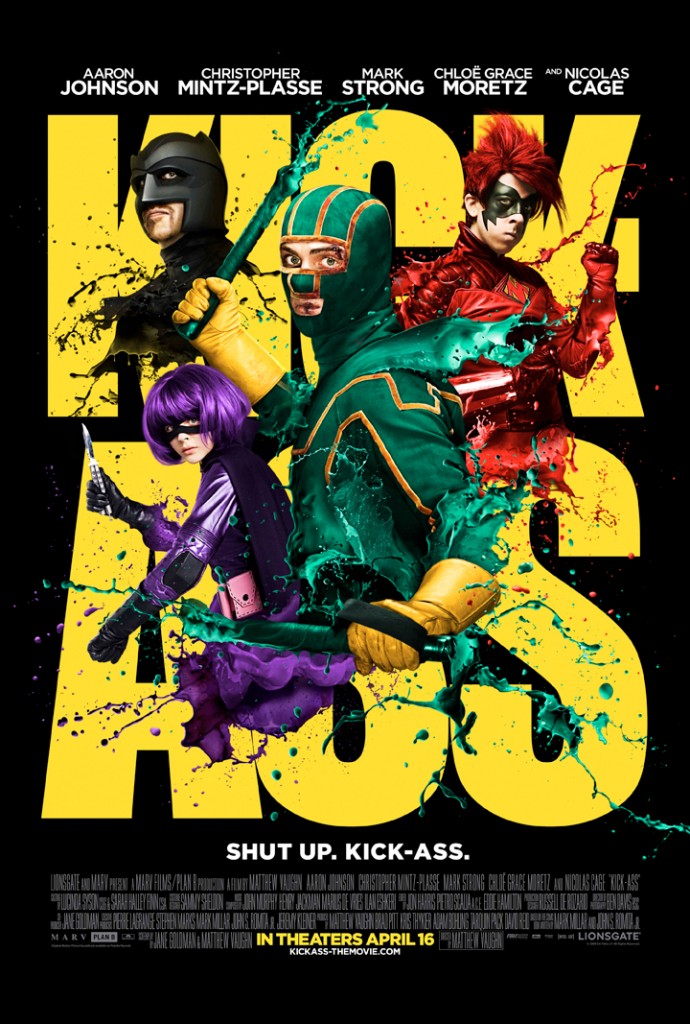
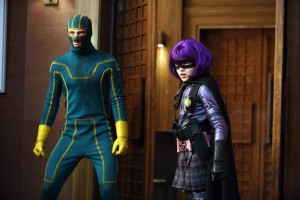
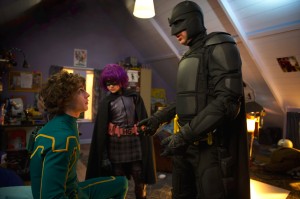
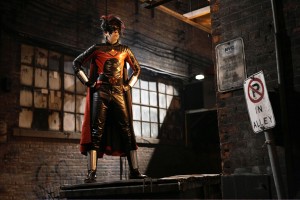
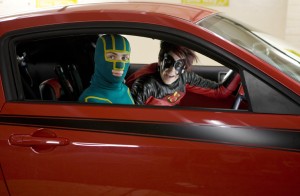
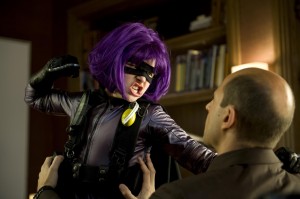
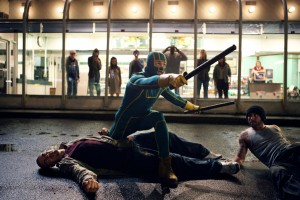

One of the few negative reviews that I can respect. I personally thought Kick-Ass was well worth the ticket money I paid three times here in the UK, but you explain your reasons very well and avoid the moral maze that other critics have become ensnared in (and yes, I’m primarily thinking about the same two people you have the foresight to mention).